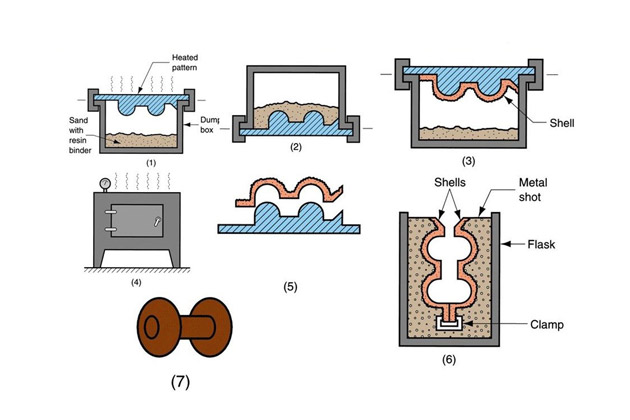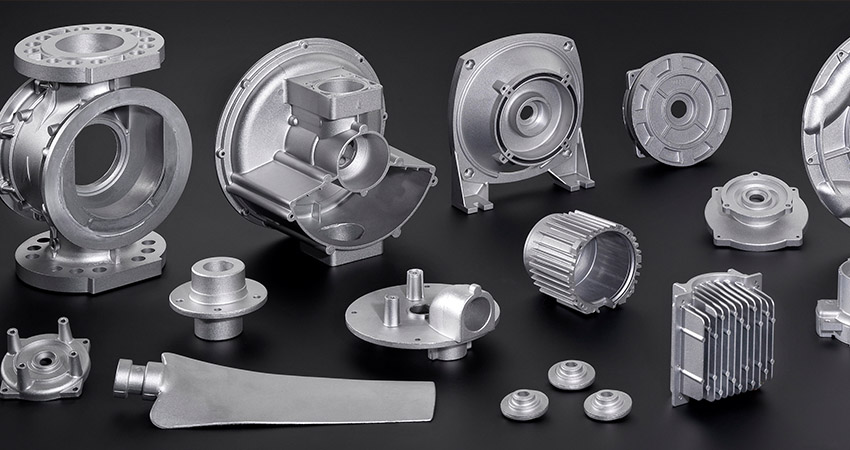Why Aluminum Casting is the preferred choice for automotive
Every little thing You Required to Know About the Uses and Perks of Aluminum Castings
Aluminum castings play a vital role throughout various industries, offering unique homes that improve product efficiency. Their light-weight nature and toughness make them optimal for applications in vehicle and aerospace industries. Additionally, the flexibility of casting methods enables detailed styles and tight resistances. As the demand for lasting solutions rises, understanding the advantages and applications of aluminum castings ends up being significantly crucial. What certain benefits do they use over various other materials?
Overview of Aluminum Casting Processes
Aluminum casting processes incorporate a variety of strategies made use of to form liquified aluminum right into desired kinds. These methods include sand spreading, die spreading, and investment spreading, each offering unique benefits depending on the application (Aluminum Casting). Sand casting involves developing a mold from sand, permitting elaborate styles and huge parts, while die spreading uses high stress to infuse molten aluminum into steel molds, ensuring accuracy and smooth coatings. Investment casting, likewise called lost-wax spreading, produces complicated forms with exceptional dimensional accuracy, making it ideal for thorough parts
These procedures are characterized by their capacity to create light-weight, resilient parts that show excellent rust resistance. The adaptability of aluminum enables for customization in various sectors, from vehicle to aerospace. In addition, the ability to reuse aluminum improves the sustainability of these casting processes, reducing ecological influence while preserving product honesty. Recognizing these methods is important for enhancing manufacturing performance and achieving high-quality aluminum castings.
Trick Applications of Aluminum Castings
Aluminum castings play an essential duty across various markets, especially in automobile, aerospace, and consumer electronics. In the vehicle sector, they add to light-weight structures that improve fuel effectiveness. Aerospace components benefit from aluminum's strength-to-weight proportion, while consumer electronics utilize its adaptability for effective manufacturing.
Automotive Market Applications
As the automobile sector continues to evolve, manufacturers significantly rely upon aluminum castings for their lightweight yet resilient buildings. These castings play a crucial role in improving automobile efficiency, fuel performance, and overall security. Secret applications include engine blocks, transmission housings, and structural elements, which gain from aluminum's exceptional strength-to-weight ratio. Furthermore, aluminum castings promote complex geometries, permitting cutting-edge designs that enhance the rules of aerodynamics and decrease drag. The rust resistance of aluminum additionally adds to long life, minimizing maintenance prices for both suppliers and consumers. As electrical automobiles gain appeal, aluminum castings are crucial for battery rooms and other components, additionally strengthening their significance in the future of automobile manufacturing.
Aerospace Element Manufacturing
In the aerospace field, aluminum castings are integral to the production of lightweight, high-performance components. These castings are necessary for producing parts such as engine real estates, structural frameworks, and landing equipment parts, where weight decrease is important for gas effectiveness and overall performance. The exceptional strength-to-weight proportion of aluminum allows for the growth of complex geometries that enhance aerodynamics. Furthermore, aluminum's resistance to corrosion adds to the longevity and reliability of aerospace components, guaranteeing safety and security in trip operations. The spreading procedure additionally permits precise tolerances, which is crucial in meeting strict aerospace industry criteria. In general, aluminum castings play a critical duty beforehand aerospace modern technology while sustaining the industry's press for sustainable practices.
Customer Electronic Devices Manufacturing
Making use of aluminum castings in customer electronics manufacturing has actually ended up being progressively considerable because of their light-weight and resilient properties. Producers utilize these castings to produce components for various gadgets, consisting of smartphones, laptops, and gaming consoles. Aluminum's superb thermal conductivity additionally helps in heat dissipation, improving device performance and durability. In addition, the flexibility of aluminum permits elaborate designs and complex geometries, allowing smooth and modern-day looks that appeal to consumers. Furthermore, aluminum castings can be conveniently recycled, aligning with the growing need for sustainable manufacturing techniques. As modern technology advances, the role of aluminum castings in creating innovative and effective consumer electronic devices is expected to expand, making them a staple in the industry.

Advantages of Using Aluminum Castings
While various products are offered for casting, aluminum attracts attention as a result of its special mix of light-weight properties, strength, and corrosion resistance. The low thickness of aluminum makes it an excellent option for applications where weight reduction is crucial, such as in the auto and aerospace sectors. Its superb strength-to-weight ratio permits manufacturers to produce long lasting elements without adding extreme weight.
Furthermore, aluminum castings can be generated with detailed layouts and limited resistances, making it possible for complex geometries that are hard to accomplish with other products. The adaptability of aluminum permits numerous casting techniques, consisting of sand, pass away, and investment casting, catering to varied manufacturing requirements. Aluminum's ease of machining and ending up enhances its appeal, facilitating the production of high-quality surface coatings. Overall, the advantages of making use of aluminum castings contribute to improved performance and performance in various applications across different markets.
Corrosion Resistance in Aluminum Castings

Natural Oxide Layer
An all-natural oxide layer types on the surface area of aluminum castings, offering a vital barrier against environmental aspects that can cause damage. This thin, safety movie is an outcome of the aluminum's response with oxygen airborne, effectively protecting the underlying metal from dampness, chemicals, and contaminants. Because of this, aluminum castings exhibit impressive deterioration resistance, which boosts their longevity and resilience in numerous applications. The oxide layer is not just helpful for defense however likewise contributes to aesthetic top qualities, as it can establish a matte surface that numerous industries find enticing. In addition, this all-natural procedure minimizes the demand for additional layers, making aluminum castings a cost-efficient selection for makers seeking reputable, resilient materials.
Alloy Variations Impact
The structure of aluminum alloys greatly affects their deterioration resistance homes in castings. Various alloy variants, such as 1xxx, 2xxx, and 6xxx series, exhibit unique degrees of susceptibility to deterioration. 1xxx alloys, largely made up of pure aluminum, offer excellent deterioration resistance due to their high pureness. In comparison, 2xxx alloys, which consist of copper, might experience considerable deterioration when revealed to rough atmospheres. 6xxx alloys, incorporating magnesium and silicon, strike a balance between stamina and resistance. The visibility of alloying components can enhance or reduce protective oxide layers, eventually affecting longevity and efficiency. Understanding these variants is necessary for choosing the ideal alloy for specific applications websites where rust resistance is important.
Layout Adaptability and Personalization
Although numerous products exist for casting applications, aluminum stands out due to its exceptional style adaptability and possibility for customization. This adaptability enables developers and engineers to produce elaborate forms and kinds that fulfill certain functional demands. Aluminum Casting. The low density of aluminum enables light-weight layouts, which is especially helpful in industries such as automotive and aerospace, where weight decrease is essential
Aluminum castings can be customized to various specifications, including wall surface thickness, surface coating, and dimensional tolerances. This versatility not just enhances the visual appeal but additionally improves the performance of the last product. Additionally, advanced methods such as 3D printing and computer-aided style (CAD) additional facilitate the personalization process, allowing quick prototyping and minimizing preparations. As a result, aluminum castings can successfully fulfill the varied needs of different sectors while using suppliers the ability to innovate and respond swiftly to market needs.
Contrast With Other Casting Materials
While different casting products each have their distinct benefits, aluminum regularly demonstrates premium properties that make it a favored selection in numerous applications. Contrasted to iron and steel, aluminum is considerably lighter, which decreases the overall weight of ended up items, boosting fuel effectiveness in vehicle and aerospace markets. Aluminum uses outstanding rust resistance, calling for less maintenance over time contrasted to products like iron, which can rust.
When juxtaposed with plastics, aluminum's toughness and durability surpass lots of artificial alternatives, making it suitable for requiring settings. In enhancement, aluminum's thermal and electrical conductivity is extremely greater than most other steels, making it optimal for applications requiring reliable warmth dissipation or electric parts.

Future Trends in Aluminum Casting Modern Technology
Advancements in aluminum casting modern technology are readied to look at more info redefine its applications across different markets. Technologies in automation and robotics are improving production procedures, enhancing efficiency and accuracy. The combination of expert system and artificial intelligence enables real-time tracking and predictive maintenance, minimizing downtime and enhancing quality control.
Furthermore, the growth of advanced alloys is increasing the performance abilities of aluminum castings, making them appropriate for more demanding applications, specifically in automotive and aerospace fields. Sustainable practices are also acquiring traction, with increased emphasis on recycling aluminum and lowering carbon impacts throughout manufacturing.
Additive manufacturing strategies, such as 3D printing, are being checked out to develop complex geometries that traditional techniques can not accomplish, enabling greater style versatility. These patterns indicate a future where aluminum spreading will not just fulfill yet surpass industry expectations, driving development and sustainability in manufacturing.
Regularly Asked Concerns
How Are Aluminum Castings Recycled After Use?
Aluminum castings are typically collected, cleaned up, and processed in recycling centers. The material is thawed down, refined, and then reformed into new products, therefore saving resources and reducing ecological impact while preserving aluminum's desirable properties.
What Are the Typical Expenses Connected With Aluminum Castings?
The regular expenses related to aluminum castings differ based on elements such as intricacy, volume, and material specs. Typically, rates vary from a couple of dollars per pound to considerably greater quantities for intricate styles and big amounts.
How Do Aluminum Castings Compare in Weight to Steel Castings?
Aluminum castings evaluate significantly less than steel castings, blog here generally around one-third the weight (Aluminum Casting). This decreased mass enables much easier handling, transport, and application in different sectors, adding to boosted efficiency in style and production procedures
What Industries Mainly Depend On Aluminum Castings?
Various markets significantly depend on aluminum castings, including automobile, aerospace, electronics, and durable goods. Their light-weight nature, deterioration resistance, and versatility make them crucial for making elements in these industries, enhancing efficiency and performance.
Exist Any Kind Of Wellness Threats Associated With Aluminum Casting Processes?
Wellness risks connected with aluminum casting procedures consist of direct exposure to fumes, dirt, and chemicals, which can lead to respiratory system problems and skin irritation. Proper precaution and tools are vital to mitigate these potential risks in the workplace.